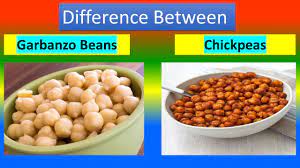The Mystery: Chickpeas vs. Garbanzo Beans
Chickpeas and garbanzo beans are legumes that have caused some confusion in the culinary world. Many people wonder if they are the same or different. In this article, we will explore the terminology, botanical characteristics, culinary uses, nutritional profiles, and finally, answer the burning question: Are chickpeas and garbanzo beans the same?
Exploring the Terminology

Chickpeas and garbanzo beans are two terms often used interchangeably to refer to the same legume. Chickpeas are known scientifically as Cicer arietinum and are a part of the Fabaceae family. On the other hand, garbanzo beans, or Cicer arietinum var. sativum, are a subspecies of chickpeas. The term “chickpeas” is commonly used in English-speaking countries, while “garbanzo beans” is more prevalent in Spanish-speaking regions and the United States.
Botanical Similarities and Differences
Botanically, chickpeas and garbanzo beans share many similarities. They both belong to the same species and have a similar appearance, shape, and size. Both legumes are round and have a beige or light tan color. However, there are some slight differences between the two. Garbanzo beans tend to have a slightly darker shade and a slightly rougher texture compared to chickpeas. In terms of taste, they are almost identical, with a nutty and creamy flavor.
Culinary Uses and Preparations
Chickpeas and garbanzo beans are incredibly versatile and used in various culinary applications around the world. Both legumes are commonly used in soups, stews, salads, and curries. They can be cooked and mashed to make hummus, or roasted for a crunchy snack. In Mediterranean and Middle Eastern cuisines, chickpeas or garbanzo beans are a key ingredient in traditional dishes like falafel and hummus.
While the cooking methods and recipes for chickpeas and garbanzo beans are similar, there may be slight variations based on regional preferences. For example, in Indian cuisine, chickpeas are often used in dishes like chana masala, while in Mexican cuisine, garbanzo beans are used in dishes like chiles en nogada. However, in most cases, chickpeas and garbanzo beans can be used interchangeably in recipes without any significant difference in taste or texture.
Nutritional Profile
Both chickpeas and garbanzo beans are highly nutritious legumes that offer a range of health benefits. They are an excellent source of plant-based protein, making them a valuable addition to vegetarian and vegan diets. In terms of macronutrients, both legumes contain a similar amount of protein and carbohydrates. However, garbanzo beans tend to have slightly higher fat content compared to chickpeas.
When it comes to micronutrients, chickpeas and garbanzo beans are rich in fiber, folate, iron, phosphorus, and manganese. They also provide significant amounts of potassium, magnesium, and vitamin B6. These legumes are low in saturated fat and have a low glycemic index, making them suitable for individuals with diabetes or those looking to manage their blood sugar levels.
Myth Busting: Are They the Same?
After exploring the terminology, botanical characteristics, culinary uses, and nutritional profiles, we can conclude that chickpeas and garbanzo beans are indeed the same. While there may be slight differences in regional preferences and cultural variations in the usage of the terms, both refer to the same legume species, Cicer arietinum. The terms “chickpeas” and “garbanzo beans” can be used interchangeably in most contexts without any significant distinction.
FAQs
Are chickpeas and garbanzo beans interchangeable in recipes?
Yes, chickpeas and garbanzo beans can be used interchangeably in recipes without any noticeable difference in taste or texture.
Can chickpea flour be substituted with garbanzo bean flour?
Yes, chickpea flour and garbanzo bean flour are the same thing, so they can be used interchangeably in recipes.
Are chickpeas and garbanzo beans equally nutritious for vegans?
Yes, both chickpeas and garbanzo beans are excellent sources of plant-based protein and offer similar nutritional benefits for vegans.
Do chickpeas and garbanzo beans have the same cooking time?
Yes, chickpeas and garbanzo beans have similar cooking times and can be prepared using the same methods.
Are chickpeas and garbanzo beans safe for individuals with gluten intolerance?
Yes, chickpeas and garbanzo beans are naturally gluten-free and can be safely consumed by individuals with gluten intolerance.
Can chickpeas and garbanzo beans be sprouted for added nutritional benefits?
Yes, both chickpeas and garbanzo beans can be sprouted, which enhances their nutritional value and digestibility.
Are chickpeas and garbanzo beans suitable for individuals with diabetes?
Yes, chickpeas and garbanzo beans have a low glycemic index and can be included in a balanced diet for individuals with diabetes.
What are the potential allergenic properties of chickpeas and garbanzo beans?
Chickpeas and garbanzo beans can cause allergic reactions in some individuals, particularly those with legume allergies. It is important to be cautious if you have known allergies.
Can chickpeas and garbanzo beans be used interchangeably in hummus?
Absolutely! Both chickpeas and garbanzo beans can be used to make delicious and creamy hummus.
Are there any cultural or regional preferences for using one term over the other?
Yes, there are cultural and regional preferences for using either “chickpeas” or “garbanzo beans” based on language and tradition. However, the legumes themselves are the same.
Conclusion
Chickpeas and garbanzo beans may have different names, but they refer to the same leg. chickpeas and garbanzo beans are the same thing. They refer to the same legume, scientifically known as “Cicer arietinum.” The use of the term “chickpeas” is more common in English, while “garbanzo beans” is often used in Spanish-speaking regions and some other parts of the world. Despite the different names, they are identical types of beans and can be used interchangeably in recipes.




